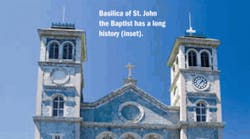St. John the Baptist Cathedral in St. John’s, Newfoundland, Canada, was consecrated in 1855. One hundred years later, Pope Pius XII raised the cathedral to the rank of minor basilica, in recognition of its historical, artistic, and ecclesiastical importance. It since has been designated a National Historic Site of Canada and a Provincial Historic Site.
History, however, has its downsides. In 2011, the basilica still was relying on part of its original heating and piping system. Not only was the system past its prime, it was way beyond its life expectancy, inefficient, and at risk of failure. An extensive retrofit was needed.
A team of architects, engineers, and HVAC and controls contractors would work together to bring the facility two centuries forward.
Objectives
The objectives of the project were many: change the heating system and replace piping, locate temperature sensors throughout the building for precise monitoring, and automate heating and cooling control with data gathered by the sensors—all the while, as Tony Dawe of engineering firm Stantec put it, “keep(ing) the amount of interior tear-up to an absolute minimum because it is a national historic site.”
Plan
The heating system was to be replaced with heat pumps. The cast-iron radiators would be swapped for new fan-coil units, limiting the footprint of the retrofit. For sensing and control, wireless technology would be used to limit wiring and repair work and preserve the historical elements of the interior. The control system had to be capable of integrating all of the wireless sensing and control points into a BACnet building automation system (BAS), providing remote programmable control without physical alterations to the decor.
Exterior and Structural Retrofit
The oil-fired, water-based heating system was replaced with heat pumps from Mitsubishi Electric Cooling & Heating. Also, new arteries were put in place. A tunnel was dug through the foundation of the basilica for refrigeration pipes. Electrical service was upgraded to accommodate the conversion from oil heat to heat pumps. In some instances, flooring was removed temporarily.
Building-Automation Retrofit
Building-automation platform CAN2GO from SCL Elements Inc. was chosen because of its unique ability to offer wired and wireless (EnOcean and ZigBee protocols) networking and control options, as well as BACnet integration.
For the wireless temperature sensors and thermostats, EnOcean-based products were chosen for their energy-harvesting capabilities. With such devices, not only is communication wireless, no power supply or battery is required. Each unit generates its own power using photovoltaic cells. The low-power solution generates enough energy to send short wireless telegrams for sensing and control.
“Due to the historical significance of the basilica and the lack of wiring options, there was a requirement that wireless temperature sensors be used in the main church area,” Barry Goulding of system integrator Newfoundland HVAC said. “Since there are about 80 heat-pump fan coils installed in this area and in many smaller rooms and hallways, we used 20 EnOcean thermostats and 10 UN2 CAN2GO controllers. All of the CAN2GO controllers communicated via ZigBee. The CAN2GO system was very easily integrated into our DDC (direct digital control) front end through BACnet and allowed us to provide accurate heating control in the church. CAN2GO provided excellent product support throughout the project.”
Detailed BAS Setup
As shown in Figure 1:
1) CAN2GO controllers are installed discreetly inside the fan-coil units in the basilica. Their external antennas provide great range, despite the metal casing of the fan coils.
2) Each CAN2GO controller integrates neighboring wireless sensors and thermostats based on EnOcean energy-harvesting technology. No wiring is needed.
3) CAN2GO controllers network wirelessly using their ZigBee mesh capabilities and push all wireless points as BACnet points to the third-party BACnet system. No wiring, except for an Ethernet cable for the master node of the network, which is connected to the local-area network, is needed.
With precise temperature information coming from all corners of the basilica, the BACnet system can drive the heat pumps for maximum comfort and energy efficiency.
Conclusion
“The client has just gone through his first heating season and is very happy with the performance of the new system,” Kerry Gosse, project manager for PHB Group, the architectural firm in charge of the project, said.
Every retrofit job offers its own set of challenges. Some can be more daunting than others. The Basilica of St. John the Baptist is an extreme case, in which typical wiring and repair work were out of the question. But it does show the flexibility and wide variety of options available to building-automation stakeholders looking to reduce invasiveness, labor costs, and downtime.
For Design Solutions author guidelines, call Scott Arnold, executive editor, at 216-931-9980, or write to him at [email protected].









